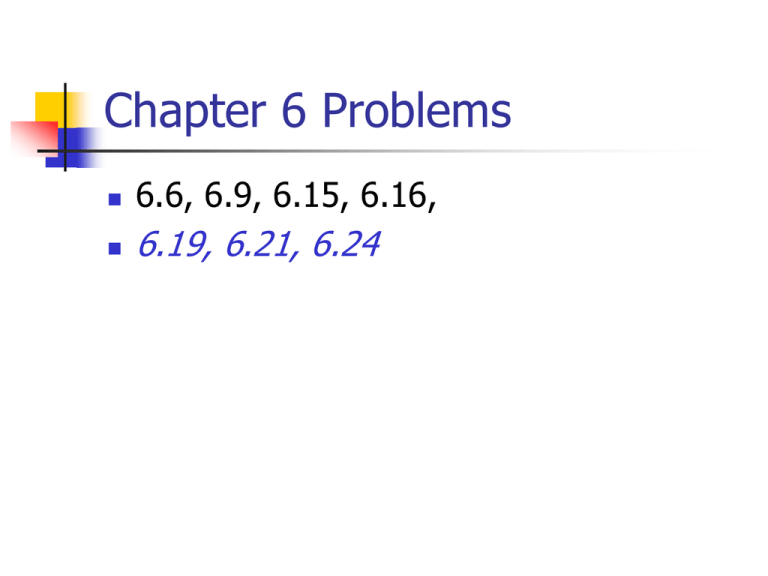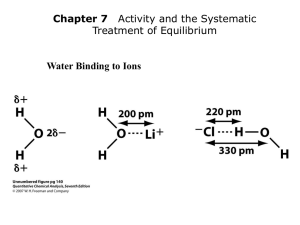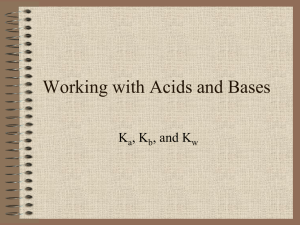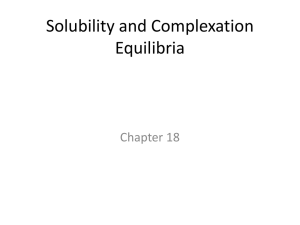Lecture 13 Notes
advertisement

Chapter 6 Problems 6.6, 6.9, 6.15, 6.16, 6.19, 6.21, 6.24 Chapter 6 Chemical Equilibrium Chemical Equilibrium Equilibrium Constant Solubility product (Ksp) Common Ion Effect Separation by precipitation Complex formation Solubility Product Introduction to Ksp Solubility Product solubility-product the product of the solubilities solubility-product constant => Ksp constant that is equal to the solubilities of the ions produced when a substance dissolves Solubility Product For silver sulfate Ag2SO4 (s) 2 Ag+(aq) + SO4-2(aq) Ksp = [Ag+]2[SO4-2] Solubility of a Precipitate in Pure Water EXAMPLE: How many grams of AgCl (fw = 143.32) can be dissolved in 100. mL of water at 25oC? AgCl <=> Ag+ + ClKsp = [Ag+][Cl-] = 1.82 X 10-10 (Appen. F) EXAMPLE: How many grams of AgCl (fw = 143.32) can be dissolved in 100. mL of water at 25oC? AgCl(s) Initial Change Equilibrium Ag+ (aq) + Cl- (aq) Some - - -x -x +x +x +x +x (x)(x) = Ksp = [Ag+][Cl-] = 1.82 X 10-10 x = 1.35 X 10-5M EXAMPLE: How many grams of AgCl (fw = 143.32) can be dissolved in 100. mL of water at 25oC? x = 1.35 X 10-5M How many grams is that in 100 ml? # grams = (M.W.) (Volume) (Molarity) = 143.32 g mol-1 (.100 L) (1.35 x 10-5 mol L-1) = 1.93X10-4 g = 0.193 mg Solubility Product For silver sulfate Ag2SO4 (s) 2 Ag+(aq) + SO4-2(aq) Ksp = [Ag+]2[SO4-2] The Common Ion Effect Ag2CO3 2 Ag+ + CO3-2 What is the effect on solubility of Ag2CO3 if I add CO3-2? The Common Ion Effect Add common ion effect a salt will be less soluble if one of its constituent ions is already present in the solution The Common Ion Effect EXAMPLE: Calculate the molar solubility of Ag2CO3 in a solution that is 0.0200 M in Na2CO3. Ag2CO3 2 Ag+ + CO3-2 Ksp = [Ag+]2[CO3-2] = 8.1 X 10-12 EXAMPLE: Calculate the molar solubility of Ag2CO3 in a solution that is 0.0200 M in Na2CO3. Ag2CO3 2 Ag+ + CO3-2 Initial Solid - 0.0200M Change -x Solid +2x +2x +x 0.0200+x Equilibrium Ksp = [Ag+]2[CO3-2] = 8.1 X 10-12 Ksp=(2x)2(0.0200M + x) = 8.1 X 10-12 4x2(0.0200M + x) = 8.1 X 10-12 EXAMPLE: Calculate the molar solubility of Ag2CO3 in a solution that is 0.0200 M in Na2CO3. 4x2(0.0200M + x) = 8.1 X 10-12 no exact solution to a 3rd order equation, need to make some approximation first, assume the X is very small compared to 0.0200 M 4X2(0.0200M) = 8.1 X 10-12 4X2(0.0200M) = 8.1 X 10-12 X= 1.0 X 10-5 EXAMPLE: Calculate the molar solubility of Ag2CO3 in a solution that is 0.0200 M in Na2CO3. X = 1.0 X 10-5 M (1.3 X 10-4 M in pure water) Second, check assumption [CO3-2] = 0.0200 M + X ~ 0.0200 M 0.0200 M + 0.00001M ~ 0.0200M Assumption is ok! Separation by Precipitation Separation by Precipitation Complete separation can mean a lot … we should define complete. Complete means that the concentration of the less soluble material has decreased to 1 X 10-6M or lower before the more soluble material begins to precipitate Separation by Precipitation EXAMPLE: Can Fe+3 and Mg+2 be separated quantitatively as hydroxides from a solution that is 0.10 M in each cation? If the separation is possible, what range of OH- concentrations is permissible. Add OH- Mg2+ Mg2+ Fe3+ Fe3+ Fe3+ 3+ Fe 2+ Mg2+ Mg Mg2+ Mg2+ Fe3+ 3+ Fe 3+ Mg2+ 2+ Fe Mg Fe3+ Fe3+ Fe3+ Mg2+ 2+ Mg2+ Mg Fe3+ Fe3+ Mg2+ Mg2+ Mg2+ Mg2+ Mg2+ Mg2+ Mg2+ Mg2+ Mg 2+ Mg2+ Mg2+ Fe3+ @ equilibrium What is the [OH-] ^when this happens Is this [OH-] (that is in solution) great enough to start precipitating Mg2+? Fe(OH)3(s) Separation by Precipitation EXAMPLE: Can Fe+3 and Mg+2 be separated quantitatively as hydroxides from a solution that is 0.10 M in each cation? If the separation is possible, what range of OH- concentrations is permissible. Two competing reactions Fe(OH)3(s) Fe3+ + 3OH- Mg(OH)2(s) Mg2+ + 2OH- EXAMPLE: Separate Iron and Magnesium? Ksp = [Fe+3][OH-]3 = 2 X 10-39 Ksp = [Mg+2][OH-]2 = 7.1 X 10-12 Assume quantitative separation requires that the concentration of the less soluble material to have decreased to < 1 X 10-6M before the more soluble material begins to precipitate. EXAMPLE: Separate Iron and Magnesium? Ksp = [Fe+3][OH-]3 = 2 X 10-39 Ksp = [Mg+2][OH-]2 = 7.1 X 10-12 Assume [Fe+3] = 1.0 X 10-6M What will be the [OH-] @ equilibrium required to reduce the [Fe+3] to [Fe+3] = 1.0 X 10-6M ? Ksp = [Fe+3][OH-]3 = 2 X 10-39 EXAMPLE: Separate Iron and Magnesium? Ksp = [Fe+3][OH-]3 = 2 X 10-39 (1.0 X 10-6M)*[OH-]3 = 2 X 10-39 [OH ]3 2 1033 [OH ] 1.31011 EXAMPLE: Separate Iron and Magnesium? What [OH-] is required to begin the precipitation of Mg(OH)2? [Mg+2] = 0.10 M Ksp = (0.10 M)[OH-]2 = 7.1 X 10-12 [OH-] = 8.4 X 10-6M EXAMPLE: Separate Iron and Magnesium? @ equilibrium [OH-] to ‘completely’ remove Fe3+ ^ -11 = 1.3 X 10 M [OH-] to start removing Mg2+ = 8.4 X 10-6M “All” of the Iron will be precipitated b/f any of the magnesium starts to precipitate!! Complex Ion Formation Complex Formation Consider Lead Iodide PbI2 (s) Pb2+ + 2I- Ksp = 7.9 x 10-9 What should happen if I- is added to a solution? Should the solubility go up or down? Complex Formation complex ions (also called coordination ions) Lewis Acids and Bases acid => electron pair acceptor (metal) base => electron pair donor (ligand) Effects of Complex Ion Formation on Solubility Consider the addition of I- to a solution of Pb+2 ions Pb2+ + I- <=> PbI+ [ PbI ] 2 K1 1 . 0 x 10 [ Pb2 ][I ] PbI+ + I- <=> PbI2 K2 = 1.4 x 101 PbI2 + I- <=> PbI3- K3 =5.9 PbI3+ I- <=> PbI42- K4 = 3.6 Effects of Complex Ion Formation on Solubility Consider the addition of I- to a solution of Pb+2 ions Pb2+ + I- <=> PbI+ [ PbI ] 2 K1 1 . 0 x 10 [ Pb2 ][I ] PbI+ + I- <=> PbI2 K2 = 1.4 x 101 Pb2+ + 2I- <=> PbI2 K’ =? Overall constants are designated with b This one is b2 Protic Acids and Bases Section 6-7 Question Can you think of a salt that when dissolved in water is not an acid nor a base? Can you think of a salt that when dissolved in water IS an acid or base? Protic Acids and Bases Salts Consider Ammonium chloride Can ‘generally be thought of as the product of an acid-base reaction. NH4+Cl- (s) NH4+ + Cl- From general chemistry – single positive and single negative charges are STRONG ELECTROLYTES – they dissolve completely into ions in dilute aqueous solution Protic Acids and Bases Conjugate Acids and Bases in the B-L concept CH3COOH + H2O CH3COO- + H3O+ acid + base <=> conjugate base + conjugate acid conjugate base => what remains after a B-L acid donates its proton conjugate acid => what is formed when a B-L base accepts a proton Question: Calculate the Concentration of H+ and OH- in Pure water at 250C. EXAMPLE: Calculate the Concentration of H+ and OH- in Pure water at 250C. Initial Change Equilibrium H2O H+ + OH- liquid - - -x +x +x +x +x Liquid-x Kw = [H+][OH-] = 1.01 X 10-14 KW=(X)(X) = 1.01 X 10-14 (X) = 1.00 X 10-7 Example Concentration of OHif [H+] is 1.0 x 10-3 M @ 25 oC? “From now on, Kw = assume the to 1 x 10-14 = [1 x 10-3][OH-] temperature be 25oC unless 1 x 10-11 = [OH-] otherwise stated.” [H+][OH-] pH ~ -3 -----> ~ +16 pH + pOH = - log Kw = pKw = 14.00 Is there such a thing as Pure Water? In most labs the answer is NO Why? CO2 + H2O HCO3- + H+ A century ago, Kohlrausch and his students found it required to 42 consecutive distillations to reduce the conductivity to a limiting value. 6-9 Strengths of Acids and Bases Strong Bronsted-Lowry Acid A strong Bronsted-Lowry Acid is one that donates all of its acidic protons to water molecules in aqueous solution. (Water is base – electron donor or the proton acceptor). HCl as example Strong Bronsted-Lowry Base Accepts protons from water molecules to form an amount of hydroxide ion, OH-, equivalent to the amount of base added. Example: NH2- (the amide ion) Weak Bronsted-Lowry acid One that DOES not donate all of its acidic protons to water molecules in aqueous solution. Example? Use of double arrows! Said to reach equilibrium. Weak Bronsted-Lowry base Does NOT accept an amount of protons equivalent to the amount of base added, so the hydroxide ion in a weak base solution is not equivalent to the concentration of base added. example: NH3 Common Classes of Weak Acids and Bases Weak Acids carboxylic acids ammonium ions Weak Bases amines carboxylate anion Weak Acids and Bases HA Ka H+ + A- [ H ][ A ] Ka [ HA] Ka’s ARE THE SAME HA + H2O(l) H3O+ + A- [ H 3O ][ A ] Ka [ HA] Weak Acids and Bases B + H2O Kb BH+ + OH [ BH ][OH ] Kb [ B] Relation Between Ka and Kb Relation between Ka and Kb Consider Ammonia and its conjugate base. NH3 + H2O NH4+ + H2O H2O + H2O Ka Kb NH4+ + OH- [ NH 4 ][OH ] Ka [ NH 3 ] NH3 + H3O+ [ NH 3 ][H 3O ] Kb [ NH 4 ] OH- + H3O+ [ NH 3 ][H 3O ] [ NH 4 ][OH ] K [ NH 3 ] [ NH34 ] w K [H O ][OH ] Example The Ka for acetic acid is 1.75 x 10-5. Find Kb for its conjugate base. Kw = Ka x Kb Kw Kb Ka 1.0 1014 10 Kb 5 . 7 10 1.75105 1st Insurance Problem Challenge on page 107








